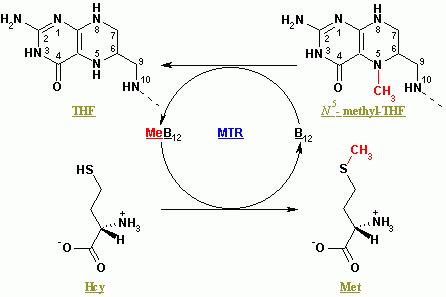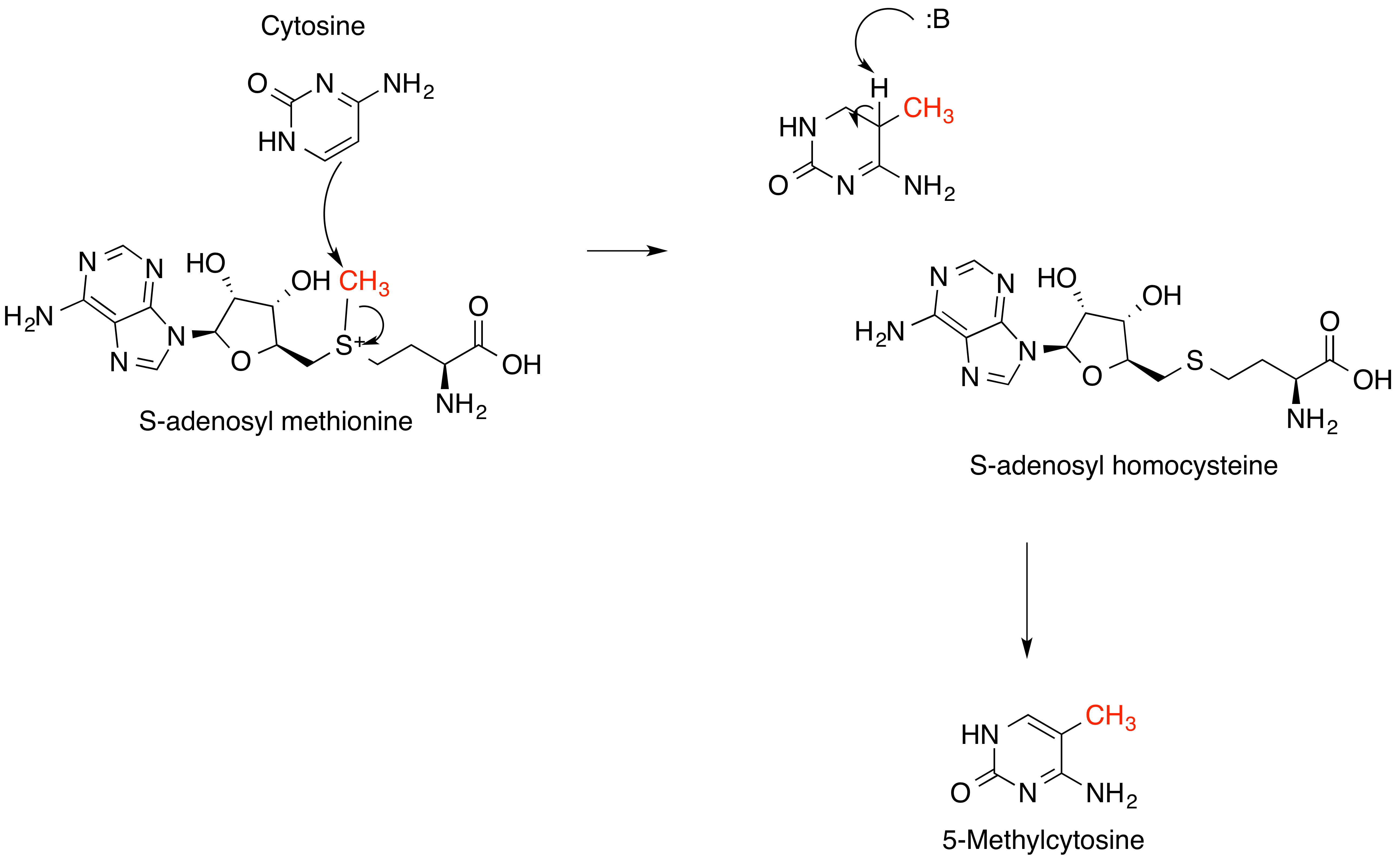|
Hyperhomocysteinemia
Hyperhomocysteinemia is a medical condition characterized by an abnormally high level of total homocysteine (that is, including homocystine and homocysteine-cysteine disulfide) in the blood, conventionally described as above 15 μmol/L. As a consequence of the biochemical reactions in which homocysteine is involved, deficiencies of vitamin B6, folic acid (vitamin B9), and vitamin B12 can lead to high homocysteine levels. Other possible causes of hyperhomocysteinemia include genetics, excessive methionine intake, and other diseases. Hyperhomocysteinemia is typically managed with vitamin B6, vitamin B9 and vitamin B12 supplementation. Hyperhomocysteinemia is a risk factor for cardiovascular disease; supplements of these vitamins may slightly reduce stroke outcome but not myocardial infarction, death from any cause or adverse events. Signs and symptoms Elevated levels of homocysteine have been associated with a number of disease states: more than 100 adverse outcomes have ... [...More Info...] [...Related Items...] OR: [Wikipedia] [Google] [Baidu] |
Homocysteine
Homocysteine (; symbol Hcy) is a non-proteinogenic α-amino acid. It is a homologous series, homologue of the amino acid cysteine, differing by an additional methylene bridge (). It is biosynthesized from methionine by the removal of its terminal Cε methyl group. In the body, homocysteine can be recycled into methionine or converted into cysteine with the aid of Vitamin B6, vitamin B6, Folate, B9, and Vitamin B12, B12. High levels of homocysteine in the blood (hyperhomocysteinemia) is regarded as a marker of cardiovascular disease, likely working through atherogenesis, which can result in Ischemia, ischemic injury. Therefore, hyperhomocysteinemia is a possible risk factor for coronary artery disease. Coronary artery disease occurs when an atherosclerotic plaque blocks blood flow to the Coronary artery, coronary arteries, which supply the heart with oxygenated blood. Hyperhomocysteinemia has been correlated with the occurrence of blood clots, heart attacks, and strokes, although ... [...More Info...] [...Related Items...] OR: [Wikipedia] [Google] [Baidu] |
Methionine Synthase
Methionine synthase (MS, MeSe, MTR) is primarily responsible for the regeneration of methionine from homocysteine in most individuals. In humans it is encoded by the ''MTR'' gene (5-methyltetrahydrofolate-homocysteine methyltransferase). Methionine synthase forms part of the S-adenosylmethionine (SAMe) biosynthesis and regeneration cycle, and is the enzyme responsible for linking the cycle to one-carbon metabolism via the folate cycle. There are two primary forms of this enzyme, the Vitamin B12 (cobalamin)-dependent (MetH) and independent (MetE) forms, although minimal core methionine synthases that do not fit cleanly into either category have also been described in some anaerobic bacteria. The two dominant forms of the enzymes appear to be evolutionary independent and rely on considerably different chemical mechanisms. Mammals and other higher eukaryotes express only the cobalamin-dependent form. In contrast, the distribution of the two forms in Archaeplastida (plants and al ... [...More Info...] [...Related Items...] OR: [Wikipedia] [Google] [Baidu] |
Cysteine
Cysteine (; symbol Cys or C) is a semiessential proteinogenic amino acid with the chemical formula, formula . The thiol side chain in cysteine enables the formation of Disulfide, disulfide bonds, and often participates in enzymatic reactions as a nucleophile. Cysteine is chiral, but both D and L-cysteine are found in nature. LCysteine is a protein monomer in all biota, and D-cysteine acts as a signaling molecule in mammalian nervous systems. Cysteine is named after its discovery in urine, which comes from the urinary bladder or cyst, from Ancient Greek, Greek κύστις ''kýstis'', "bladder". The thiol is susceptible to oxidation to give the disulfide bond, disulfide derivative cystine, which serves an important structural role in many proteins. In this case, the symbol Cyx is sometimes used. The deprotonated form can generally be described by the symbol Cym as well. When used as a food additive, cysteine has the E number E920. Cysteine is Genetic code, encoded by the codo ... [...More Info...] [...Related Items...] OR: [Wikipedia] [Google] [Baidu] |
Clinical Chemistry And Laboratory Medicine
''Clinical Chemistry and Laboratory Medicine'' is a monthly peer-reviewed scientific journal that is published by De Gruyter. History The journal was established in 1963 as ''Clinical Chemistry''/''Klinische Chemie''. In 1991 it was renamed to ''European Journal of Clinical Chemistry and Clinical Biochemistry''. In 1998 it obtained its present name. Scope The journal covers developments in fundamental and applied research into science related to clinical laboratories. It covers areas such as clinical biochemistry, molecular medicine, hematology, immunology, microbiology, virology, drug measurement, genetic epidemiology, evaluation of diagnostic markers, new reagents and systems, reference materials, and reference values. It also publishes recommendations and news from the International Federation of Clinical Chemistry and Laboratory Medicine and the European Federation of Clinical Chemistry and Laboratory Medicine. Abstracting and indexing The journal is abstracted and in ... [...More Info...] [...Related Items...] OR: [Wikipedia] [Google] [Baidu] |
Folate
Folate, also known as vitamin B9 and folacin, is one of the B vitamins. Manufactured folic acid, which is converted into folate by the body, is used as a dietary supplement and in food fortification as it is more stable during processing and storage. Folate is required for the body to make DNA and RNA and metabolise amino acids necessary for cell division and maturation of blood cells. As the human body cannot make folate, it is required in the diet, making it an essential nutrient. It occurs naturally in many foods. The recommended adult daily intake of folate in the U.S. is 400 micrograms from foods or dietary supplements. Folate in the form of folic acid is used to treat anemia caused by folate deficiency. Folic acid is also used as a supplement by women during pregnancy to reduce the risk of neural tube defects (NTDs) in the baby. NTDs include anencephaly and spina bifida, among other defects. Low levels in early pregnancy are believed to be the cause of more tha ... [...More Info...] [...Related Items...] OR: [Wikipedia] [Google] [Baidu] |
S-adenosylmethionine
''S''-Adenosyl methionine (SAM), also known under the commercial names of SAMe, SAM-e, or AdoMet, is a common cosubstrate involved in methyl group transfers, transsulfuration, and aminopropylation. Although these anabolic reactions occur throughout the body, most SAM is produced and consumed in the liver. More than 40 methyl transfers from SAM are known, to various substrates such as nucleic acids, proteins, lipids and secondary metabolites. It is made from adenosine triphosphate (ATP) and methionine by methionine adenosyltransferase. SAM was first discovered by Giulio Cantoni in 1952. In bacteria, SAM is bound by the SAM riboswitch, which regulates genes involved in methionine or cysteine biosynthesis. In eukaryotic cells, SAM serves as a regulator of a variety of processes including DNA, tRNA, and rRNA methylation; immune response; amino acid metabolism; transsulfuration; and more. In plants, SAM is crucial to the biosynthesis of ethylene, an important plant hormone and si ... [...More Info...] [...Related Items...] OR: [Wikipedia] [Google] [Baidu] |
Ectopia Lentis
Ectopia lentis is a displacement or malposition of the eye's lens from its normal location. A partial dislocation of a lens is termed lens subluxation or subluxated lens; a complete dislocation of a lens is termed lens luxation or luxated lens. Ectopia lentis in dogs and cats Although observed in humans and cats, ectopia lentis is most commonly seen in dogs. Ciliary zonules normally hold the lens in place. Abnormal development of these zonules can lead to primary ectopia lentis, usually a bilateral condition. Luxation can also be a secondary condition, caused by trauma, cataract formation (decrease in lens diameter may stretch and break the zonules), or glaucoma (enlargement of the globe stretches the zonules). Steroid administration weakens the zonules and can lead to luxation, as well. Lens luxation in cats can occur secondary to anterior uveitis (inflammation of the inside of the eye). Anterior lens luxation With anterior lens luxation, the lens pushes into the iris or ac ... [...More Info...] [...Related Items...] OR: [Wikipedia] [Google] [Baidu] |
Homocystinuria
Homocystinuria (HCU) is an inherited disorder of the metabolism of the amino acid methionine due to a deficiency of cystathionine beta synthase or methionine synthase. It is an inherited autosomal recessive trait, which means a child needs to inherit a copy of the defective gene from both parents to be affected. Symptoms of homocystinuria can also be caused by a deficiency of vitamins B6, B12, or folate. Signs and symptoms This defect leads to a multi-systemic disorder of the connective tissue, muscles, central nervous system (CNS), and cardiovascular system. Homocystinuria represents a group of hereditary metabolic disorders characterized by an accumulation of the amino acid homocysteine in the serum and an increased excretion of homocysteine in the urine. Infants appear to be normal and early symptoms, if any are present, are vague. Signs and symptoms of homocystinuria that may be seen include the following: Cause It is usually caused by the deficiency of the enzyme cyst ... [...More Info...] [...Related Items...] OR: [Wikipedia] [Google] [Baidu] |
Thrombus
A thrombus ( thrombi) is a solid or semisolid aggregate from constituents of the blood (platelets, fibrin, red blood cells, white blood cells) within the circulatory system during life. A blood clot is the final product of the blood coagulation step in hemostasis in or out of the circulatory system. There are two components to a thrombus: aggregated platelets and red blood cells that form a plug, and a mesh of cross-linked fibrin protein. The substance making up a thrombus is sometimes called cruor. A thrombus is a healthy response to injury intended to stop and prevent further bleeding, but can be harmful in thrombosis, when a clot obstructs blood flow through a healthy blood vessel in the circulatory system. In the microcirculation consisting of the very small and smallest blood vessels the capillaries, tiny thrombi known as microclots can obstruct the flow of blood in the capillaries. This can cause a number of problems particularly affecting the pulmonary alveolus, alveoli ... [...More Info...] [...Related Items...] OR: [Wikipedia] [Google] [Baidu] |
Fracture (bone)
A bone fracture (abbreviated FRX or Fx, Fx, or #) is a medical condition in which there is a partial or complete break in the continuity of any bone in the body. In more severe cases, the bone may be broken into several fragments, known as a ''comminuted fracture''. An open fracture (or compound fracture) is a bone fracture where the broken bone breaks through the skin. A bone fracture may be the result of high force impact or stress, or a minimal trauma injury as a result of certain medical conditions that weaken the bones, such as osteoporosis, osteopenia, bone cancer, or osteogenesis imperfecta, where the fracture is then properly termed a pathologic fracture. Most bone fractures require urgent medical attention to prevent further injury. Signs and symptoms Although bone tissue contains no pain receptors, a bone fracture is painful for several reasons: * Breaking in the continuity of the periosteum, with or without similar discontinuity in endosteum, as both contain mult ... [...More Info...] [...Related Items...] OR: [Wikipedia] [Google] [Baidu] |



